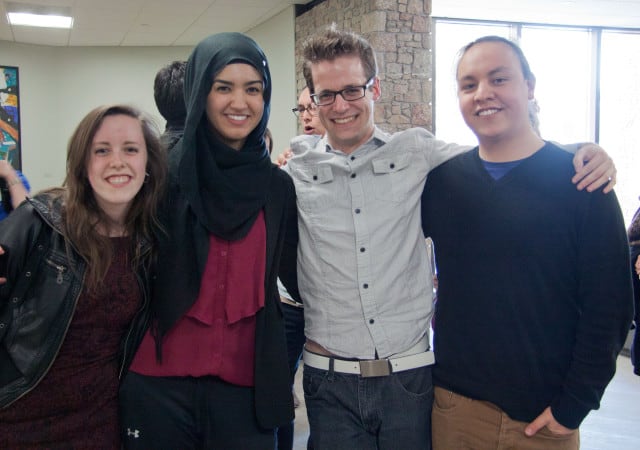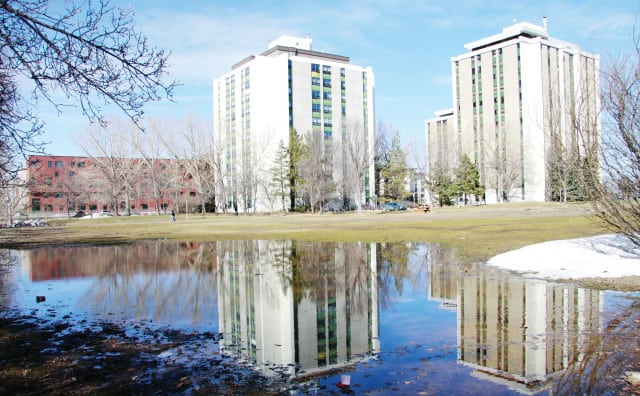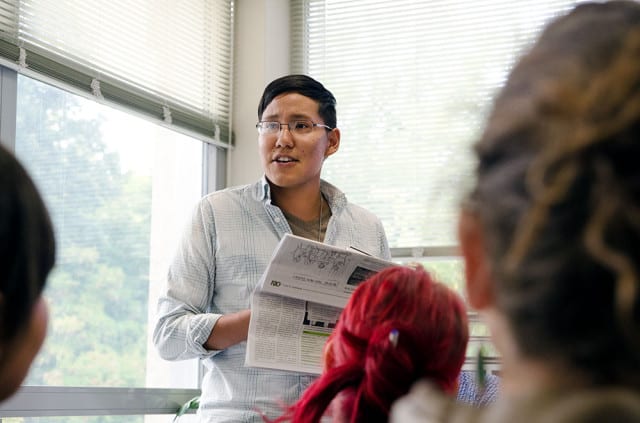[column size=one_third position=first ]
January
University begins year with cost cutting

January: Battling a future $44.5 million deficit for 2016, the U of S started the new year with some big cuts.
Announced on Jan. 11, program prioritization is expected to save the University of Saskatchewan between $20 and $25 million. TransformUS was originally intended to have University Council create two taskforces — one to rank academic programs and another for support services — comprised solely of faculty, staff and administrators.
Students were quick to note their exclusion from the taskforces and, at the Jan. 24 University Council meeting, they filled the auditorium and voiced their concerns.
Support from concerned faculty members led to council voting in favour of including one undergraduate and one graduate student on each of the two taskforces, bringing the total number of members on each up to a range of 20 to 25.
With a deficit of $44.5 million projected for the 2016 operating budget, the U of S sought out ways to trim the growing gap between revenues and expenses. Alongside TransformUS, workforce planning also began in January.
A university wide review searching for inefficiencies in its workforce led to 40 employees being laid off, saving the university an estimated $2.3 million annually. A second round of job cuts took place in April, followed by massive lay-offs during the summer that brought the total up to around 200 employees losing their jobs.
[/column]
[column size=one_third position=middle ]
March
USSU Election

March: Jenna Moellenbeck, Nour Abouhamra, Jordan Sherbino and Max FineDay were voted in as the 2013-4 USSU executive.
March is elections month for the U of S Students’ Union. This year saw a large number of candidates running for most positions, resulting in an executive with all new members.
Max FineDay beat out Brayden York and Alyssa Bredohl for the union’s president. The then third-year political studies major ran on a platform promising to protect students’ interests through an academic year that would face the challenges of program prioritization.
In an equally tight race, Jenna Moellenbeck was voted in as the vice-president of operations and finance. Running for the position a second time, Moellenbeck brought her previous experience on University Students’ Council budget and finance committee paired with her knowledge as an Edwards School of Business student to the election. Also running for the position were Rose Lien, Nathan Adams and Elias Nelson.
The vice-president of student affairs was the most sought after position, with six candidates in the running including Jeremy Yorga, Gibson Odoka, Payton Byrns, Kris Jones, Nour Abouhamra and Andrew Hartman. Abouhamra received the most votes and promised a year full of events for students.
Jordan Sherbino ran uncontested and became the new vice-president of academic affairs. Running on a platform of accessibility and transparency, Sherbino guaranteed to not only represent students when dealing with academic issues, but to give them a strong voice when working with administrators.
[/column]
[column size=one_third position=last ]
April
McEown Park begins massive renovations

April: With some residences over 40 years old, the McEown Park towers were long over due for a renovation.
Long-awaited renovations of the McEown Park residences began in April. The extensive overhaul of the buildings is expected to take 20 years.
Seager Wheeler, Souris Hall and Assiniboine Hall, which opened in 1970, and Wollaston Hall, which followed in 1976, had their carpets replaced with tile in April. Natural lighting and bed bug resistant furniture will be some of the residences’ new features. The first five years of renovations will address the areas of utmost importance.
The university conducted an engineering study to ensure the residences will be up to code structurally, electrically and mechanically.
Acting Director of University Consumer Services Martin Gonzalez previously told the Sheaf that the ground floors of the residences will be an area of focus. Currently used for storage and maintenance purposes, the ground floors could be turned into common or retail spaces.
To enhance students’ experiences and create a greater sense of community, Martin said the common spaces that are currently located at the top floor of each building may be moved down to a central floor.
The renovations are part of a campus-wide plan to rejuvenate the university’s aging buildings called RenewUS.
There is no budget set for the renovations, however, due to the university’s current financial state, prioritization will lead to addressing problem areas first while being subject to funding restraints.
[/column]
[column size=one_third position=first ]
September
OCN article ignites debate

September: Jack Saddleback speaks to a crowd about Professor Flynn’s controversial article in On Campus News.
Following a pipe ceremony on Sept. 3 celebrating the success of the university’s Indigenous Voices program, assistant professor Kevin Flynn wrote an article in the Sept. 13 issue of On Campus News titled “Honour traditions but with inclusive ceremonies.”
Flynn authored the piece after receiving an email inviting him to the pipe ceremony and providing some guidelines to the ceremony’s protocol.
The email advised women to wear long skirts if participating in the ceremony and that those “on their moon time” — menstruating — should sit outside of the circle. Flynn wrote in his article that the pipe ceremony was not inclusive towards women and that they were “marginalized.”
Flynn’s article caused an outrage on campus as students, faculty and staff members were quick to respond by saying that Flynn did not fully understand the pipe ceremony tradition and was lacking knowledge about aboriginal culture.
Indigenous Students’ Council President Terri Favel invited everyone from the campus community who felt they had been affected by Flynn’s op-ed to attend a meeting at the Aboriginal Students’ Centre.
Many students responded at the forum that they felt staff and faculty at the U of S require more training regarding aboriginal traditions and suggested having a female traditional healer come to educate about women’s moon time.
[/column]
[column size=one_third position=middle ]
October
Med school on probation
The College of Medicine was put on probation for a second time on Oct. 4. The college is Saskatchewan’s only medical school and is the only one in Canada to be given probationary status twice.
That day the Committee on Accreditation of Canadian Medical Schools/Liaison Committee on Medical Education informed the U of S that the college had received a grade of “Accreditation with Probation” following the accreditors’ visit in March.
The College of Medicine was supposed to have rectified ten areas in need of improvement by the time the accreditors came. However, the college came up short in understanding authority and responsibility, supervising students on clinical rotation and defining roles and objectives of staff and faculty towards the medical education program.
One of the continual issues the U of S medical school has faced is uncertainty in its leadership roles. Since Dr. William Albritton retired as dean of the college in 2012, the position has not been filled with a permanent candidate.
In the reorganization of the College of Medicine, three vice-deans have been created to attend to research, medical education and faculty engagement. These vice-dean positions are all filled temporarily.
Hired on from Dalhousie University as the U of S medical college’s new dean in December, Dr. Preston Smith will create his own leadership team by hiring those vacant vice-dean positions along with some department heads where required.
[/column]
[column size=one_third position=last ]
November
Grad House opens
The U of S opened its first residence that is exclusive to graduate students on Nov. 20.
The residence is the final addition to the College Quarter residences and will increase occupancy at the U of S by 262.
Graduate students were heavily consulted in the design of each unit so that their unique needs could be met. There was also a committee of students that gave recommendations for how much each apartment should cost for a student to live in it.
The new residence features four different apartment-style living arrangements. Each unit has a kitchen, major appliances, a microwave and natural lighting. Wheelchair accessible apartments are available in two styles — one for a single occupant and one designed to house the student and their assistant.
The unit styles include a smaller, economic apartment for a single student and a loft-style apartment with two bedrooms for a pair of students.
The Grad House has retail space on the ground floor, laundry facilities and many lounges for either studying or social gatherings.
Although students have their choice of roommate, families are not allowed.
This newest residence rang in a at cost of $39 million and was built between June of 2011 and December of 2013.
President of the Graduate Students’ Association Ehimai Ohiozebau said students were pleased with the residence and that it was well designed for graduate students.
[/column]